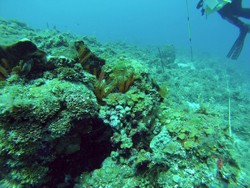
Four Decades Later, Meyer Finds Caribbean Complexities
The coral reefs of the Caribbean Sea have had a rough couple of decades, afflicted with coral disease, hurricanes, a die-off of algae-controlling sea urchins, over-harvesting of coral-friendly fish and the effects of global warming, according to paleontologist David L. Meyer, professor of geology in UCs McMicken College of Arts & Sciences.
Surveying one coral reef in Jamaica after 45 years, Meyer found that some species are clearly distressed today, while others are flourishing in a very changed habitat.
Its not a dead-zone situation, Meyer said. There is a diversity of life. Its just very different from what it was.
As a young paleontologist, Meyer took up underwater diving to study relationships between the fossilized specimens he found preserved in the rocks and their living counterparts. One of his earliest dives, in 1968, was at Discovery Bay, Jamaica, where he studied reef-dwelling crinoids also known as feather stars animals related to starfish.
Returning in April 2013 to the precise location of his 1968 survey, Meyer found that the crinoid population had exploded, with previously common animals now even more abundant by at least an order of magnitude.
It is interesting to me that these crinoids are on the upswing, while there are many studies showing declines in the vitality of Caribbean reefs, Meyer said.
The Jamaican reef exhibits this dichotomy, Meyer said. Some types of coral, particularly staghorn coral, are all-but eliminated from this location where they were common in 1968. Other types of coral appear to be surviving and growing. Algae has overtaken much of the reef while sea urchins have disappeared.
The surprising finding that crinoids have increased in abundance despite the drastic loss of coral cover should not necessarily be taken as good news for the overall health of the reef environment, Meyer said.
Meyer discovered that underwater visibility, while still very good, is significantly diminished from the clarity he enjoyed in 1968. He attributes the decline in visibility to suspended organic particles probably from decaying algae. This new organic ingredient means abundant food for the crinoids.
Although crinoid populations are increasing at the Jamaican study site, Meyer noted that crinoid populations in similar environments off Curacao and Bonaire are in steep decline.
Time, and further research, will be necessary to determine exactly how the changes recorded at Caribbean locations over 45 years occurred, Meyer said.
Meyers research was supported by a research grant from the National Geographic Society. He presented his findings in June at a meeting in Jamaica of the Association of Marine Labs of the Caribbean.
Related Stories
A year after Niger's dramatic coup
July 26, 2024
UC School of Public and International Affairs Associate Professor Alexander Thurston tells ABC News that Mali, Niger and Burkina Faso will face difficult times in the wake of armed conflicts.
Some Ohio counties have multiple congressional districts
July 25, 2024
UC Professor David Niven talks to the Ohio Capital Journal about Ohio's sometimes confusing congressional districts.
Miss Ohio makes history as first Latina to win state title
July 25, 2024
UC College of Arts and Sciences student Stephanie Finoti tells Spectrum News that as reigning Miss Ohio, she hopes to inspire other girls to pursue their dreams.
